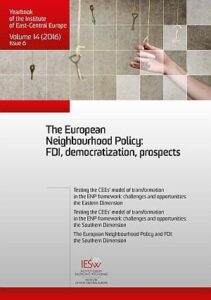Pages: 27-47
Edition: Lublin 2016
DOI: --
Citation method: K. Żukrowska, ‘Testing the CEEs’ model of transformation in the ENP framework: challenges and opportunities: the Southern Dimension’, Yearbook of the Institute of East-Central Europe, vol. 14, no. 6, 2016, pp. 27-47.
Abstract:
This paper examines the content of the transformation strategies which were applied in countries of East-Central Europe (CEEs) and highlights these of their experiences that can be emulated to countries included in the Southern dimension of the ENP. Big disparities exist among countries included in the ENP’s Southern dimension as well as among the CEEs. Nevertheless, the goal in both groups of countries has been the same, i.e. to build a stable market economy and democracy and improve citizens’ prosperity. The methods applied have a number of elements in common like the institutions engaged, models applied, instruments used. The possibilities of the application of the CEEs’ model seems to be limited at first sight but there is a number of elements that the strategies applied in both groups of countries have in common. These include the opening of the economy, cooperation with the IMF, World Bank, WTO and the EU, closer regional ties with some harmonization of laws and building a FTA, which is followed by an increasing attractiveness for investors and the stimulation of job creation and exports. On top of that, regional opening should be supported by the process of wider openness, followed by specific solutions applied internally in each of the economies.

PDF: Download